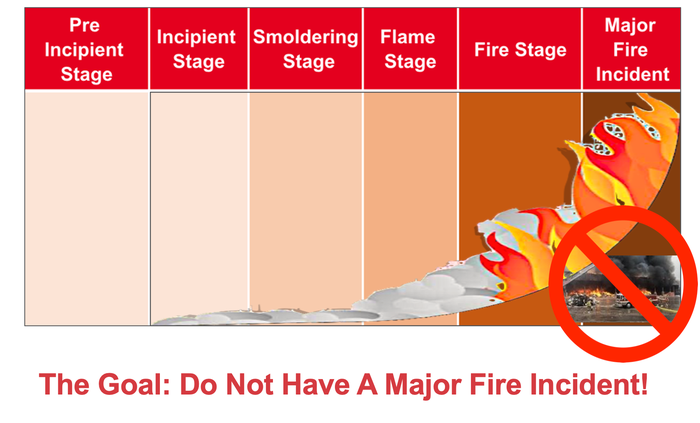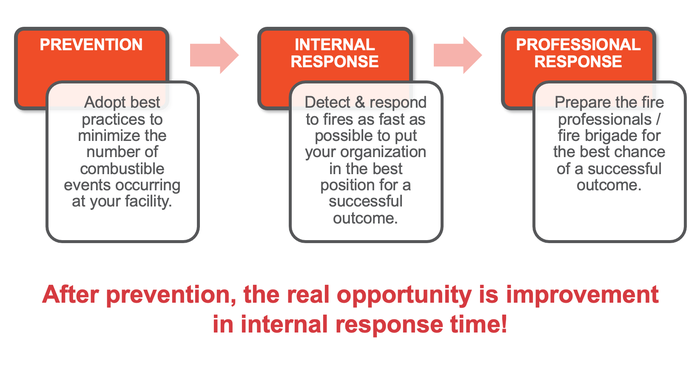Lithium-ion Battery Fires Continue to be a Growing Threat to the Industry
You cannot read the news without hearing a story about a lithium-ion battery fire incident that occurred in a high-rise building, electronic vehicle (EV), laptop on an airplane, vape in someone's pocket, a fulfillment warehouse and, of course, in a waste and recycling facility.

You cannot read the news without hearing a story about a lithium-ion battery fire incident that occurred in a high-rise building, electronic vehicle (EV), laptop on an airplane, vape in someone's pocket, a fulfillment warehouse and, of course, in a waste and recycling facility. Instead of reporting on January fires, I will wait until March to provide January and February’s data. This month, I have been hard at work on my annual report, which is scheduled to release in March and will include a breakdown of last year’s record number of fires and how to best solve the problem.
2022 In A Nutshell
Based on recent media coverage, the world is finally catching up to the problem that we in the waste and recycling industry have known for years: Lithium-ion batteries are causing fires everywhere. In November 2022, the New York City Fire Department reported “191 fires, 140 injuries and six deaths from lithium-ion fires in the city.” Councilwoman Joann Ariola, chair of the Committee on Fire and Emergency Management, said the city is on track to more than double the number of lithium-ion battery-related fires.
What took them so long? In 2017, based on my research, analysis and unique position on the frontlines with Fire Rover, I was forecasting a wave of lithium-ion battery fires in our waste streams due a number of factors. In 2018, we saw that bump on a global scale. From 2019 up until today, the waste and recycling industry’s leadership heard the call and took action to deal with these fires. These industrywide efforts included campaigns to educate the public on the dangers of lithium-ion batteries in the waste stream, operational best practices and the adoption of technologies like the Fire Rover.
With all the hoopla surrounding lithium-ion batteries as the main culprit of fires, we cannot overlook the fact that in the waste and recycling industry, fire hazards are caused by several different factors. In fact, most of the data I have seen show that batteries are responsible for about half of the fires we see in our waste and recycling streams. Other factors like accelerants, pressurized tanks, explosives and more have long been causing fires at our waste and recycling operations and cannot be overlooked.
THERE IS AN INHERENT RISK OF FIRES IN THE WASTE AND RECYCLING INDUSTRY!
I do not make that statement lightly. The problem is not going away. In fact, the past two years have been our worst years for publicly reported fires since 2015. What is causing this to happen? In a nutshell, traditional hazards combined with the onslaught of batteries in our waste and recycling streams, worsening heat across the globe and a myriad of other factors continue to make operating in this space more dangerous. Additionally, as the world seeks to become “greener,” more stress is being placed on our waste and recycling infrastructure. Hazards that used to get thrown in a landfill or illegally dumped are now being handled properly, but in turn they are causing some negative effects on our infrastructure. So, in essence, the resulting increase in fires is a good problem to have for the globe, but dangerous, nonetheless.
There are solutions to our fire problem. Many industries that have an inherent risk of fires in their operations have learned to safely operate within the constraints of their issues via education, operational best practices and investments in technology.
There are many great folks who work on educating the public about proper recycling, some of whom are highlighted in my report. In 2022, I started highlighting the problem on our Fire Rover TikTok channel. Why? To properly educate the public on the dangers of improper recycling. We need to educate the public when they are young and where can we meet them on their level. Read through some of the comments in our posts and you will soon see the realities of how hard it will be to educate our way out of this problem.
I strongly believe our waste and recycling operators are the unintended victims in the lithium-ion battery supply chain. It is only fair that some of the costs of these fire hazards, which, in my estimation, cost more than $1.2 billion dollars in the U.S. and Canada, should be borne by the manufacturers of the batteries as opposed to the operators, insurance companies and municipal fire departments. Who do you think is footing that bill? The operators, their insurance companies and fire professionals who are responding to these incidents. It’s only fair that the manufacturers be held responsible and foot at least some of the bill.
Fire departments are traditionally underfunded, and more than half of the fire professionals in the U.S. are volunteer. Specifically, there are “1,134,400 firefighters in the United States…[o]f these, 346,150 (31%) are career and 788,250 (69%) are volunteer.” The point is our fire departments deserve some funding for training and equipment to fight EV battery fires, transfer station fires, scrap metal fires and other fire incidents that may occur. The waste and recycling operators deserve the same when it comes to solutions like the Fire Rover that have proven they are a requirement when the uncontrollable risks that are inherent in your business are causing fires.
I have heard some faint discussion regarding insurance companies that are looking for the manufacturers to cover some of their losses after they have occurred. But what if we took a proactive approach to solving this problem and started holding the manufacturers responsible for providing the equipment, technology and training needed to combat the fire problem we currently face.
NOT HAVE A MAJOR FIRE INCIDENT.

Fire is not the problem until it becomes the problem. Early on in my industry tenure, I kept hearing the same thing, “Fire grows in size and scope every X seconds/minutes.” Put in whatever compounding factor you want, but the reality is the earlier you catch a fire, the better chance you have at mitigating the risk to employees, fire professionals, operations and physical infrastructure.

So, what does that really mean?
Prevention: It’s the operator’s job to follow best practices to minimize a fire.
Internal Response: Outside of a fire brigade, the operators must train their employees on best practices such as when it is safe for them to respond and when they must evacuate. In addition, they should invest in solutions like the Fire Rover that detect the fire early with thermal cameras, optical flame and smoke detectors; eliminate the need for a response when the situation warrants; and can engage the fire professionals when warranted.
Professional Response: Arming and equipping our fire professionals with the proper tools, training, techniques and education to successfully fight these types of fire hazards.
Successfully fighting fire problems on a long-term basis requires a combination of all parties working together in lockstep and ready to respond when and if the situation arises. Since no two fire incidences are the same, no two responses are the same, which is why we need a framework that allows for flexibility, quick thinking and proper actions to ensure if an operator has a fire incident that it is not “major” or “catastrophic.”
In 2022, my team at Fire Rover was responsible for more than 1,500 saves at our 350-plus client operations. We have never had a catastrophic incident that began in an area that we protect. Are we perfect? No, but we have successfully fought any major incident that we faced with minimal damage to any of our clients’ facilities. We currently protect eight of the top ten waste and recycling companies in the country along with family-owned operations, municipalities and corporations in the U.S., Canada, the UK, France and Australia. Is it always pretty? No, sometimes it is downright ugly, but our results speak for themselves. The fact is “fire” is ugly. The same two incidents rarely happen twice and never in the same exact way. You have to prepare for the unknown and react within seconds to overcome constantly changing factors and challenges.
Even with our performance, 2022 was the highest year for reported waste and recycling facilities fires that we have experienced since I began consolidating the data in 2016. We even beat last year’s record, which I incorrectly thought was our high-water line.
Why is this number significant? We know the number of batteries we use in personal electronics and personal storage equipment is only growing. I previously made the statement that 2021’s high number of reported incidents was possibly due to 2020’s pullback during the COVID-19 pandemic. The assumption is the waste and recycling tonnage slowed down in 2020 and was pushed into 2021.

What we learned in 2022 was that not only is the lithium-ion battery hazard on the rise in our waste and recycling facilities, but it is starting to garner major public attention outside of our space. Batteries are catching fire on airplanes, in EVs, in high-rise buildings, in scooters and more. This has caused the media to finally focus on the problem, which is both a blessing and a curse. In reality, lithium-ion batteries are a relatively safe technology. According to Victoria Hutchison, a research project manager at the Fire Protection Research Foundation, “One out of every 10 million lithium-ion batteries fails, a condition that almost always leads to a fire.” The issue is that batteries that are treated improperly, incorrectly charged or made with substandard parts/materials are the ones that burn. Just like the public is hard on their electronic scooters by hitting corners, jumping on and off sidewalk curbs and charging 20 at a time, the waste and recycling industry is hard on its trash. Unless someone can figure out a way to be gentler with our waste and recycling, the industry deserves some resources to stop the public’s bad recycling behavior and resources to help deal with the inherent risk thrust upon them.
The best practice of “water, water, water,” which is a fire response approach used for hundreds if not thousands of years, is evolving into early detection and immediate response. Lowering the risk of catastrophic incidents through operational, technological and professional best practices puts the waste and recycling industry in a good position to stem the tide over the next couple of years, even with the onslaught of hazards continuing to barrage our waste and recycling streams across the globe.
Conclusion
As I finalize the 6th edition of the "Waste & Recycling Facility Fires Annual Report," I look forward to breaking down the hazards of the different incidents by material, state, tonnage and more with the ultimate goal of finding new trends or learnings from these incidents. To be first in line to get a copy, subscribe to my newsletter at “Fire Safety Report,”or email me directly at [email protected].
Ryan Fogelman, JD/MBA, is vice president of strategic partnerships for Fire Rover. He is focused on bringing innovative safety solutions to market, and two of his solutions have won the distinguished Edison Innovation Award for Industrial Safety and Consumer Products. He has been compiling and publishing the “Reported Waste & Recycling Facility Fires In The US/CAN” since February 2016 and the “Waste & Recycling Facility Fires Annual Report.” Fogelman regularly speaks on the topic of the scope of fire problems facing the waste and recycling industries, early detection solutions, proper fire planning and early-stage fire risk mitigation. Additionally, Fogelman is on the National Fire Protection Association’s Technical Committee for Hazard Materials. (Connect with Ryan on LinkedIn at https://www.linkedin.com/in/ryanjayfogelman or email at [email protected])
About the Author
You May Also Like




